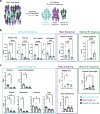This is a preprint.
Parkinson's disease is characterized by vitamin B6-dependent inflammatory kynurenine pathway dysfunction
- PMID: 39399688
- PMCID: PMC11469709
- DOI: 10.21203/rs.3.rs-4980210/v1
Parkinson's disease is characterized by vitamin B6-dependent inflammatory kynurenine pathway dysfunction
Update in
-
Parkinson's disease is characterized by vitamin B6-dependent inflammatory kynurenine pathway dysfunction.NPJ Parkinsons Dis. 2025 Apr 26;11(1):96. doi: 10.1038/s41531-025-00964-7. NPJ Parkinsons Dis. 2025. PMID: 40287426 Free PMC article.
Abstract
Parkinson's disease (PD) is a complex multisystem disorder clinically characterized by motor, non-motor, and premotor manifestations. Pathologically, PD involves neuronal loss in the substantia nigra, striatal dopamine deficiency, and accumulation of intracellular inclusions containing aggregates of α-synuclein. Recent studies demonstrate that PD is associated with dysregulated metabolic flux through the kynurenine pathway (KP), in which tryptophan is converted to kynurenine (KYN), and KYN is subsequently metabolized to neuroactive compounds quinolinic acid (QA) and kynurenic acid (KA). This multicenter study used highly sensitive liquid chromatography-tandem mass-spectrometry to compare blood and cerebral spinal fluid (CSF) KP metabolites between 158 unimpaired older adults and 177 participants with PD. Results indicate that increased neuroexcitatory QA/KA ratio in both plasma and CSF of PD participants associated with peripheral and cerebral inflammation and vitamin B6 deficiency. Furthermore, increased QA tracked with CSF tau and severity of both motor and non-motor PD clinical dysfunction. Importantly, plasma and CSF kynurenine metabolites classified PD participants with a high degree of accuracy (AUC = 0.897). Finally, analysis of metabolite data revealed subgroups with distinct KP profiles, and these were subsequently found to display distinct PD clinical features. Together, these data further support the hypothesis that the KP serves as a site of brain and periphery crosstalk, integrating B-vitamin status, inflammation and metabolism to ultimately influence PD clinical manifestation.
Keywords: Kynurenine pathway; Parkinson’s disease; cerebrospinal fluid; inflammation; metabolism; plasma; vitamin B.
Conflict of interest statement
Competing interests: The authors declare that they have no competing interests.
Figures





References
-
- Poewe W. et al. Parkinson disease. Nature Reviews Disease Primers 3 (2017). https://doi.org:ARTN17013/nrdp.2017.13 - PubMed
Publication types
Grants and funding
- R01 AG048076/AG/NIA NIH HHS/United States
- P30 AG066518/AG/NIA NIH HHS/United States
- P30 AG066515/AG/NIA NIH HHS/United States
- RF1 AG058047/AG/NIA NIH HHS/United States
- R01 AG074339/AG/NIA NIH HHS/United States
- P50 NS062684/NS/NINDS NIH HHS/United States
- K23 NS075097/NS/NINDS NIH HHS/United States
- R37 NS115139/NS/NINDS NIH HHS/United States
- R01 AG048232/AG/NIA NIH HHS/United States
- P30 AG072979/AG/NIA NIH HHS/United States
- R01 NS115114/NS/NINDS NIH HHS/United States
- P01 AG084497/AG/NIA NIH HHS/United States
- U24 AG021886/AG/NIA NIH HHS/United States
- R35 GM138353/GM/NIGMS NIH HHS/United States
- R01 NS115139/NS/NINDS NIH HHS/United States
LinkOut - more resources
Full Text Sources

